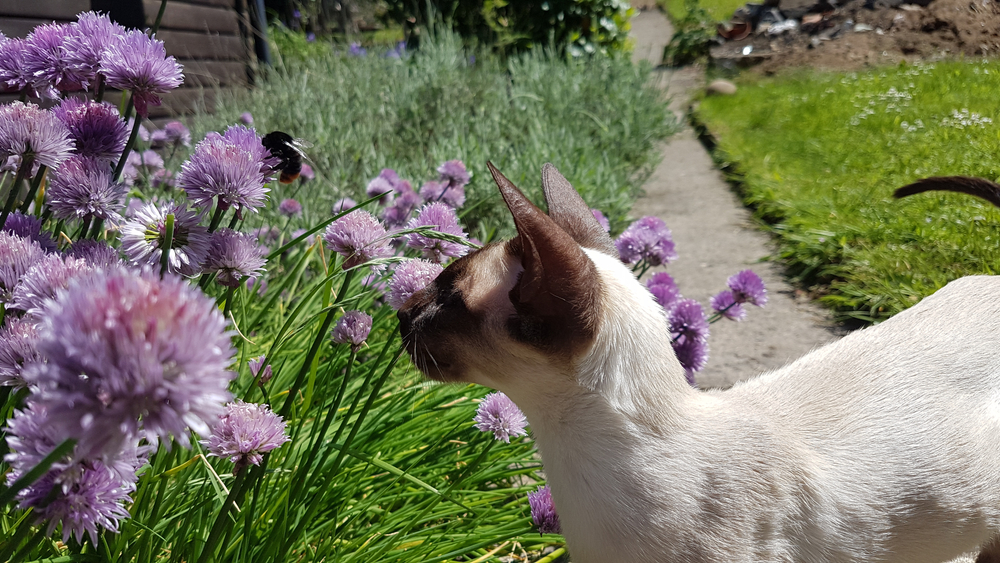Cats are curious creatures, and it’s only natural for that curiosity to land them in some sticky situations from time to time. Whether it’s getting stuck in a crawlspace, breaking your beloved antique vase, or cheekily tucking into your unattended dinner, our kitty friends sure do make life interesting.
But for cats who enjoy spending time in the garden, there are a few more things that can go wrong. Namely, insect bites and stings. Perhaps the most common of all of them is a painful kiss from our honey-making friends. But how can you know if your cat was stung by a bee? And, more importantly, how should you treat a bee sting?
Let’s find out.
How to tell if your cat was stung by a bee
Was your cat stung by a bee? Since cats can’t simply tell us they were stung by a bee, we have to put on our detective hats and hunt for clues. If you’ve ever been stung by a bee before, you’ll be familiar with the symptoms we humans exhibit – pain, swelling, and redness, to name a few. But what about our feline friends?
Well, cats tend to show similar signs when they’ve been stung by a bee, but if they’re particularly fluffy, it can be difficult to tell right away.
For a cat stung by a bee, there are a few key areas on the body to check out. Because they tend to paw at and nose their prey, the face and paws are the most commonly stung parts of the body for cats. Here are the key signs that indicate your cat may have been stung by a bee:
- Swelling in a certain area
- Constantly biting or licking a certain area
- Pawing at a certain area
- More frequent meowing and vocalisation
It’s also important to keep in mind that many cats are the strong, silent type. As such, you may not even know that they’ve been stung. For most cats, they’ll simply get better on their own and you’ll be none the wiser. However, it’s essential to recognise the signs of an allergic reaction, as it could be life-threatening.
Signs your cat is allergic to bee stings
Once again, the symptoms of an allergic reaction to bee stings in cats is quite similar to those of humans. A serious reaction to a sting is rare in cats, but for a Cat Owner or trusted Cat Sitter, it’s still well worth learning and keeping an eye out for these symptoms:
- Excessive swelling (even somewhere other than the sting site)
- Hives anywhere on the body
- Panting or difficulty breathing
- Drooling, vomiting, or diarrhea
- Pale gums
- Dizziness
- Unusually fast or slow heart rate
Most signs of allergic reaction appear within the first hour (or first few hours) of the initial sting. If you notice any of the above signs, take your cat to a vet immediately. If left undetected and untreated, they could go into anaphylactic shock, which can be fatal.
How to treat a cat stung by a bee
As mentioned above, it’s possible that your cat has been stung by a bee before and simply not been too bothered by it. However, if you do notice a bee sting, there are a few things you can do to help Felix recover a little faster.
- Remove the stinger. Bees are the only insects who leave their stinger inside their victim. It’s part of what makes a sting so painful, as the stinger can continue to secrete venom after the initial sting. To remove the stinger, use a credit card to flick it out from your cat’s skin. Try not to use tweezers, as this could squeeze more venom into the wound
- Tend to the swelling. It may take some time for the swelling to go down completely, but you can help by applying an ice pack or cool towel to the sting site for about 10 minutes
- Prevent further irritation. It’s natural for your cat to lick at and scratch the sting, but this can slow healing and possibly lead to infection. If you have a “cone of shame” handy (or perhaps even a travel pillow), it may be worth donning it on your kitty to prevent any scratching or biting
- Keep them hydrated and fed. Ensure your cat has plenty of water to drink and monitor their appetite. If the sting occurred near their mouth, it may be painful to eat dry food. In this case, moisten it or treat them to some wet food
How to prevent your cat being stung by a bee
There’s no way to definitively prevent your cat getting stung by a bee. After all, even if they’re an indoor cat, it’s still possible a bee could make its way inside. However, there are a couple of steps you can take to lower the chances of your furry family member getting stung.
Firstly, monitor your home for hives. If you find a beehive on your property, don’t try using pesticides or remove it by force. Instead, call in a professional beekeeper to safely remove it, along with its inhabitants. This way, your home will be (hopefully) bee-free and the bees will have a new home. Win-win!
The other option if you want to keep your cat safe indoors but still allow them to enjoy the outside world is to install an outdoor cat enclosure. Also called a “catio”, this structure gives your kitty the option to venture outside safely or stay indoors. Check out our guide for more information about outdoor cat enclosures


